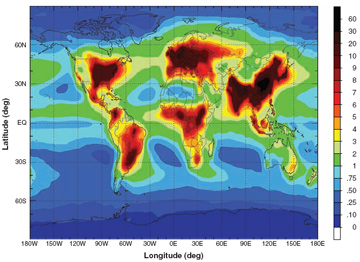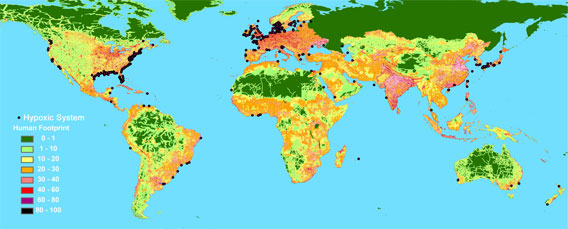Marine dead zones spread exponentially, doubling every decade since 1960
Marine ‘dead zones’ double every decade
Jeremy Hance, mongabay.com
August 14, 2008
|
|
The number of marine dead zones have doubled every decade since the 1960s and show no sign of abating, warn scientists writing in the journal Science.
Dead zones have expanded across the ocean at alarming rates. Currently 415 sites—usually along coastlines—have shown signs of seasonal to persistent hypoxia—a severe lack of oxygen. In a review, researchers Robert Diaz and Rutger Rosenberg argue that marine dead zones have “become a major worldwide environmental problem”, occupying a portion of the ocean equal to that of the United Kingdom. Growth continues to accelerate.
Dead zones are caused by agricultural runoff, especially nitrogen-rich fertilizers, and the burning of fossil fuels. The pollutants cause marine eutrophication, whereby the ecosystem receives too many nutrients, triggering massive algae blooms, which eventually die and are broken down bacteria. By breaking down the algae the bacteria consume excessive amounts of oxygen, essentially starving the marine system.
 Estimated N deposition from global total N (NOy and NHx) emissions, totaling 105 Tg N per year. Image appeared in J.N. Galloway et al (2008). “Transformation of the Nitrogen Cycle: Recent Trends, Questions, and Potential Solutions,” Science 16 May 2008. |
The majority of dead zones are near large populations in wealthy nations. For example, the United States’ east coast is covered with hypoxia sites, as is much of western and northern Europe. Such areas—heavy in industry, fishing, and runoffs from intensive agriculture—spew massive amounts of nutrient-rich pollutants into the sea.
The authors note that “most of these systems were not hypoxic when first studied, but it appears that from the middle of the past century, the dissolved oxygen concentrations of many coastal ecosystems have been adversely affected by eutrophication.” A number of human-related factors likely caused the sudden explosion of dead zones, but certainly the development in the 1940s of mass-produced fertilizer containing nitrogen is a major culprit.
Dead zones live up to their name in terms of biomass, the loss of which adds greater strains on already overfished and overexploited oceans. As an example, the researchers note that the Kattegat sea—between Denmark and Sweden—has experienced high levels of fish mortality and a collapse of their lobster industry due to eutrophication. In addition, they estimate that if the entire Baltic Sea recovered from eutrophication it would be one-third to one-half more productive—a boon for Scandinavian fishermen and a reprieve from other fishing areas.
 Global distribution of the 400+ marine systems with dead zones caused by increased eutrophication. Their distribution matches the current human “footprint” in the northern hemisphere. In the southern hemisphere, dead zones have only been reported recently. [Image courtesy of Science/AAAS] |
While the trends are bleak, the authors suggest some solutions.
“The key to reducing dead zones will be to keep fertilizers on the land and out of the sea,” they write. “For agricultural systems in general, methods need to be developed that close the nutrient cycle from soil to crop and back to agricultural soil.”
Thus far, little has been done to deal with the problem. Only four percent of the 415 dead zones had shown any improvement by the end of the 1990s. If governments and the public-at-large begin to take the issue seriously, the researchers believe the seas could be recovered, at least partially: “we believe it would be unrealistic to return to preindustrial levels of nutrient input, but an appropriate management goal would be to reduce nutrient inputs to levels that occurred in the middle of the past century, before eutrophication began to spread dead zones globally.”
Related articles
U.S. dead zones may reach record levels this summer
(7/15/2008) “Dead zones” in the Gulf of Mexico and Chesapeake Bay will likely expand to record levels this summer due to rising rising agricultural runoff in part triggered by large-scale flooding in the Midwest, according to a forecast by a researcher from the University of Michigan.
Nitrogen pollution harming ecosystems and contributing to global warming
(5/15/2008) Nitrogen pollution of the world’s oceans is harming marine ecosystems and contributing to global warming, report two reviews published in the journal Science.
Ocean dead zones have nearly quadrupled since 1994
(4/3/2008) Coastal areas worldwide are suffering from over-enrichment of their waters by nitrogen and phosphorus, finds a new study from the World Resources Institute (WRI). This over-enrichment, known as eutrophication, causes numerous environmental problems, eventually devastating coastal environments. In overly nutrient-rich waters phytoplankton, micro- and macroalgae grow to excessive portions; these ‘algal blooms’ diminish subaquatic vegetation, damage coral reefs, and deplete populations of fish, shellfish, marine mammals, and sea birds. In the worst case scenarios the massive algal blooms form hypoxic or dead zones due to loss of oxygen in the water, essentially condemning the ecosystem.